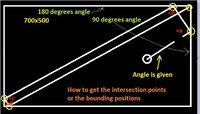Simulation Scenario:
I have 700x500 size of a rectangle
The first angle of the ball when bouncing the edge of the rectangle is 40degrees.
Starting position of the ball is:
Px = 450
Py = 350
Assuming there is no friction or gravity as I just want to simulate the path of the ball.
What are the points when the ball reaches to the wall as it bounces 5x of the rectangle?
How to get the reflection points that are located at the sides of the table?
Thank you.
I have 700x500 size of a rectangle
The first angle of the ball when bouncing the edge of the rectangle is 40degrees.
Starting position of the ball is:
Px = 450
Py = 350
Assuming there is no friction or gravity as I just want to simulate the path of the ball.
What are the points when the ball reaches to the wall as it bounces 5x of the rectangle?
How to get the reflection points that are located at the sides of the table?
Thank you.

